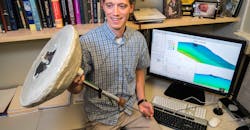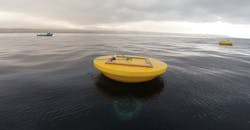Using Wave Power to Desalinate Seawater
Engineers at Atmocean Inc. in New Mexico are developing a pump that uses ocean wave power to send pressurized seawater onto shore, where it is desalinated without the use of any external energy. They are working with engineers at Sandia National Laboratories and outside funding sources, thanks to a New Mexico Small Business Assistance program. The goal is to produce a simple device that can be set up cheaply and in rural settings to provide fresh water for drinking and farming in coastal cities.
The system uses typical ocean waves and an array of seawater pumps that could send pressurized water to an onshore desalinization facility. Atmocean’s current design features a 200-ft by 200-ft array of pumps floating on the ocean. Each pump is a buoy on a piston and, the buoy takes in sea water as waves pass by. Then as the buoy settles, it pumps the seawater through hydraulic lines back to shore, where it goes through a zero-electricity reverse-osmosis desalination process.
Tim Koehler, a Sandia National Laboratories mechanical engineer, is using computational-fluid-dynamics modeling to help Atmocean, based in Santa Fe, New Mexico, with the design of a buoy and pump—shown here in a miniature prototype. An array of buoys will power a facility that desalinates ocean water for coastal cities. (Photo by Randy Montoya)
Water arrives onshore at about 180 psi. Atmocean relies on energy recovery devices—essentially spinning mechanical wheels—to boost 14% of the arriving seawater to 900 psi, the pressure needed to run reverse osmosis. The system, which is the size of a shipping container, is manufactured by Atmocean industry partners.
The system runs 24/7 and production depends on wave action. In southern Peru, where the company set up a prototype for testing, 50 million cubic feet of pressurized water would be pumped to shore in a year under typical ocean conditions. Fourteen percent of that is desalinated, producing 5 million cubic feet of fresh water annually that can be used for agriculture or consumption.
The system is inexpensive to operate, according to Atmocean, and creates local employment as well as helps the environment. Each array of pumps creates a de facto marine protected area with artificial structures that encourge marine growth. Small boats operated by local fishermen get consistent work to maintain and service the pumps.
Buoys float off the coast of Ilo, Peru, in a test of a wave energy device developed at Atmocean with technical help from Sandia National Laboratories. (Photo courtesy of Atmocean Inc.)
Atmocean is now working with Sandia engineers to improve the pump design. They want to find out what forces the ocean puts on the buoys with the passage of waves, so they can optimize pump performance and be as efficient as possible. They are using computational-fluid-dynamics modeling to evaluate various buoy designs already tested in wave pools.
After updating the pumps and evaluating them in a test tank at the Texas A&M University Haynes Laboratory, the system will be deployed later in the year off the coast of Newfoundland for a third round of testing that will demonstrate the prototype in an operational environment.



